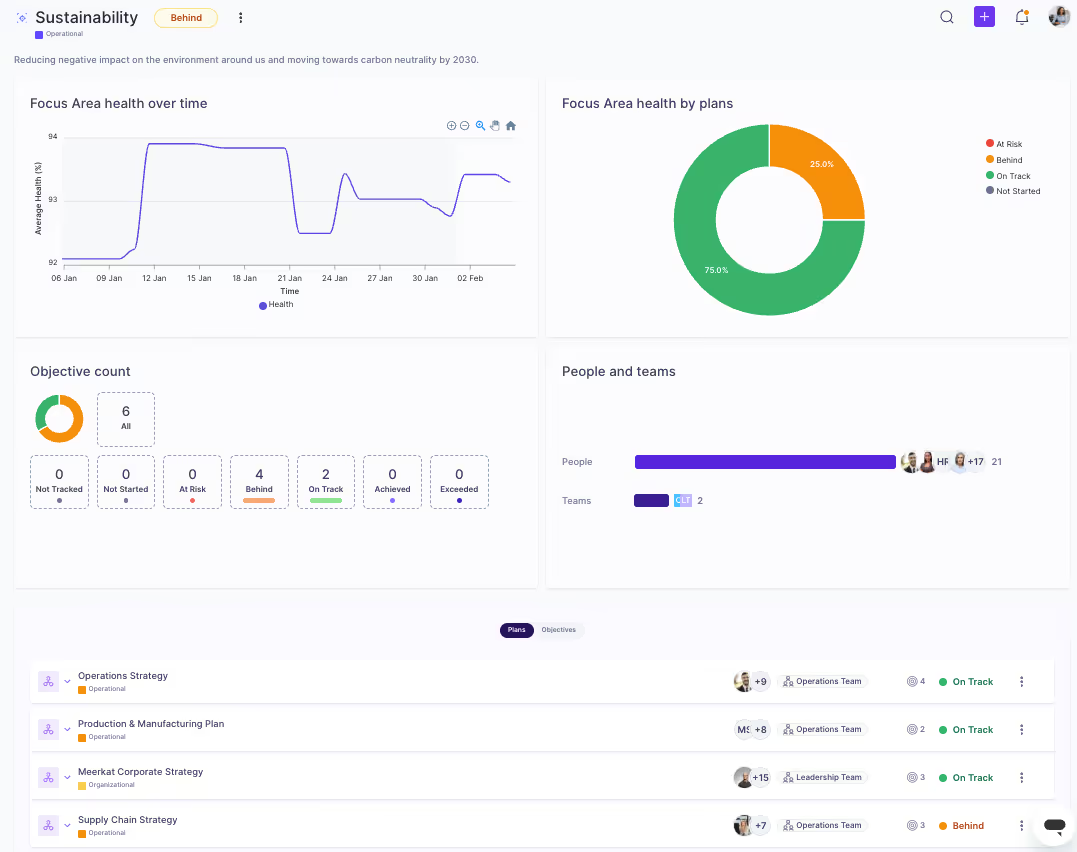Are you confident your teams are laser-focused on strategic priorities right this minute? For strategy officers and leadership teams, this question is a daily drumbeat, underscoring the constant challenge of keeping the focus on strategic objectives.
While pinpointing strategic priorities might seem easy, the real behemoth lies in aligning teams and pushing initiatives forward against the tide of daily operations. The challenge is undeniable.
In this guide, we’ll explore practical strategies for not just setting but also for executing strategic priorities, including:
- How to align teams with strategic priorities
- How to establish horizontal and vertical alignment
- How to track the progress of strategic priorities
- How to scale strategic efforts with Cascade
How To Set Strategic Priorities?
Strategic priorities are crucial for guiding resource allocation, annual operating planning, decision-making, and performance measurement against goals. These priorities vary between organizations but must align with long-term goals and direction to positively influence business performance and stakeholder value.
In this section, we go through some key steps to setting strategic priorities.
1. Analyze business environment
Netflix's pivot from DVD rentals to streaming services exemplifies the power of strategic agility and the importance of setting the right priorities in response to technological advancements and consumer behavior shifts.
Just as Netflix reinvented its service offerings to stay ahead, consider how your organization might need to pivot to meet evolving market demands.
First, run an internal analysis to grasp business performance and capabilities. Then, assess areas for improvement. Externally, examine market competition, regulatory environment, and other factors impacting your business.
Dive deep with these questions:
- What operational capabilities does your organization excel in?
- How can you enhance your value proposition to attract more consumers?
- Are there any unmet needs in the market that could lead to innovative product development?
- How do your internal and external stakeholders perceive your organization?
- Are there new competitors that can endanger your position in the market?
These are just a few of the examples. We recommend you use strategy frameworks like the SWOT Analysis or Porter’s Five Forces to identify the right roadmap for success and critical vulnerabilities. If needed, combine these frameworks to get the most comprehensive insights into your organization’s performance.
💡Make sure the leadership team and managers are involved in this step. They’re not just decision-makers but also insight-gatherers. Their involvement guarantees a better understanding of the problem and stronger buy-in when the strategic priorities are set.
2. Limit the number of strategic priorities to 3 - 5 focus areas
Restricting strategic priorities to 3-5 focus areas after analyzing opportunities and weaknesses ensures a balance between ambition and resources. This approach will help you avoid the risks of dilution from too many goals or underperformance from too few.
Identify and organize your strategic priorities in three groups:
- Critical priority
- Important priority
- Desirable priority
Give top priority to areas promising business growth, profitability, and fostering innovation.
Articulate your focus areas with clear, outcome-oriented goals such as launching new high-quality products, enhancing customer satisfaction, increasing retention rates, advancing environmental sustainability, reducing delivery times, and expanding your global business network and partnerships.
Here’s an example of focus areas for a strategic plan built in Cascade, our strategy execution platform:

💡Ensure your focus areas are straightforward and motivational, empowering your teams to excel and deliver on strategic objectives underneath each focus area.
3. Define clear timelines
Strategic priorities should have clear, achievable deadlines to promote accountability among stakeholders. A good rule of thumb is to set them within a 3- to 5-year window.
However, remain flexible with these timelines, ready to reevaluate and adapt swiftly to evolving external challenges.
After setting clear timelines, you and your teams should be able to draw up action plans and plot periodic milestones to evaluate performance.
💡Cascade enables strategic planning within pre-set time horizons, ensuring everyone plans and works on their goals within the required timeframes.
4. Apply Balanced Scorecard Framework

Implement the Balanced Scorecard Framework to systematically categorize your strategic priorities across four key perspectives: customer, financial, internal process, and learning and growth.
To simplify your process, use our Balanced Scorecard Template to organize your priorities into four focus areas and define clear key performance indicators (KPIs) for each.
📚Recommended reading: The Only Balanced Scorecard Software You’ll Ever Need (2025)
How To Align Team Goals With Strategic Priorities?
Picture this: Team A works on Project X, Team B on Project Y, and neither knows how they contribute to the bigger picture. Chaos, right?
In our recent World Strategy Day survey, a striking 51% of 230 strategy leaders pinpointed alignment as their top challenge, underscoring the struggle to translate strategic priorities into team actions.
With the average company juggling 30 to 40 distinct teams and as many technology systems, it's no wonder there is a lack of alignment and visibility into each team's strategic contribution.
To overcome this, organizations need an efficient method to manage collaborations among their myriad tools and teams to realign with strategic priorities. Cascade provides a twofold solution:
Horizontal alignment
Horizontal alignment happens when teams from various departments or business units actively coordinate their activities within shared focus areas. This concept of alignment breaks down the practice of each department operating on its own objectives in isolation rather than in collaboration with other units.
According to an Accenture study, 93% of leaders believe that functional silos are the biggest impediment to growth. This emphasizes the critical need for strategic alignment.
Here's a glimpse of horizontal alignment in action within Cascade:

This example highlights a Shared Focus Area, offering a clear view of plans, objectives, and teams driving its success. This visibility paves the way for streamlined cross-functional collaboration, ensuring that all teams have clear direction in strategy execution.
Vertical alignment
Vertical alignment unfolds when specific department goals align with overarching organizational strategic objectives. Achieving this involves a combined top-down and bottom-up approach: departments set their objectives to echo the organization's strategic goals.
Here's vertical alignment visualized in Cascade:

This Alignment Map provides a clear visual representation of how aligned your functional units are with organizational strategy.
This clarity is crucial to:
- Understand how departments impact top-level objectives.
- Connect operational objectives with strategic outcomes.
- Revise and adapt goals as strategy evolves.
- Enhance decision-making through improved visibility and context.
📚Recommended reading: Horizontal vs. Vertical Strategic Alignment
How To Track The Progress Of Your Strategic Priorities?
Consolidating data and obtaining team updates is time-consuming and error-prone, often hindering real-time visibility into performance and timely decision-making. The usual culprits are disconnected systems and conventional manual processes.
To track progress more efficiently, organizations should start by creating a centralized strategy execution hub, where they can plan, execute, and track their strategies. This makes it easier to find real-time information, especially when you have multiple cross-functional teams working toward shared goals.
In Cascade, progress tracking is simplified through:
- Metrics Libray helps consolidate business metrics in one place and connect them with key strategic initiatives. This clarity allows teams to determine which key metrics to measure and work towards.
- Dashboards let you analyze live data and keep a pulse on business performance.
- Reports simplify creating progress reports and sharing progress insights, enriching your analysis with business context for stakeholders.

Use Cascade To Plan And Execute Strategic Priorities
Cascade offers a comprehensive strategy execution platform for CSOs and their organizations to set, execute, and track strategic priorities. Its features ensure alignment across the organization, provide real-time visibility into progress, and facilitate a focused approach toward achieving strategic goals.
Get your strategic priorities together in one easy-to-use platform. Let Cascade act as the strategic brain of your business, so you can focus on what moves the needle.
Ready to see it in action? Book your live demo now.





.png)
.jpg)
.jpg)
%20(1)%20(1)%20(1)%20(1)%20(1).png)



